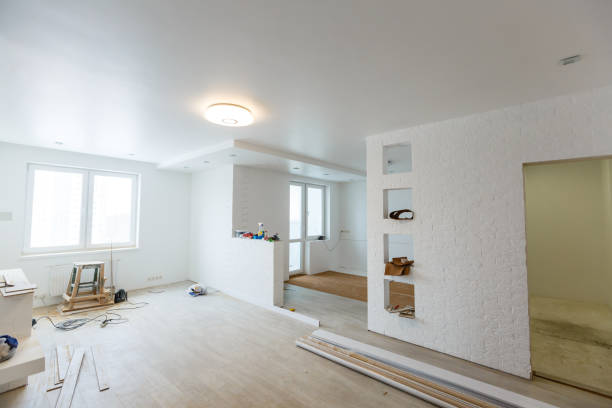

Sustainable remodeling is gaining significant traction as homeowners increasingly prioritize eco-friendly choices for their homes. This conscious approach to home improvement seeks to minimize the environmental footprint of construction while enhancing the long-term well-being of both the occupants and the planet. Environmental concerns, such as climate change and resource depletion, have motivated homeowners to explore environmentally responsible construction and design. This article will delve into the various facets of sustainable remodeling, outlining key eco-friendly materials, innovative construction techniques, and the overall benefits of this approach. We’ll discuss how these practices can save money and create healthier living environments. The following sections will provide detailed insights into the most effective strategies for achieving a sustainable home remodel, covering aspects ranging from materials selection to energy-efficiency upgrades.
Understanding the Concept of Sustainable Remodeling
Defining Sustainable Remodeling
Sustainable remodeling goes beyond simply using green materials. It encompasses a holistic approach to home improvement, integrating environmentally friendly building practices throughout the entire process. This includes choosing sustainable materials, optimizing energy efficiency, reducing waste, and minimizing the project’s overall environmental impact. Sustainable remodeling projects strive to create homes that are both aesthetically pleasing and environmentally sound.
The Growing Demand for Eco-Friendly Homes
Homeowners are increasingly drawn to sustainable remodeling as they recognize its potential to create a healthier living space and a more positive environmental footprint. Increased awareness of climate change and resource depletion is driving this shift. Many homeowners are eager to make eco-conscious choices, not only to lessen their impact on the planet, but also to save money on energy costs and increase the value of their property. The market for sustainable construction is booming, with a growing number of businesses and professionals dedicated to sustainable remodeling.
Choosing Eco-Friendly Building Materials
Sustainable Wood Alternatives
Traditional lumber often has a significant carbon footprint due to deforestation. Sustainable remodeling encourages the use of alternative wood options such as bamboo, reclaimed wood, and sustainably harvested timber. Reclaimed wood, for instance, provides a unique aesthetic appeal while reducing the demand for new resources. Bamboo, a rapidly renewable resource, is an excellent alternative to traditional timber in many applications. This mindful selection of materials greatly reduces the environmental impact of the project.
Beyond Wood: Other Eco-Friendly Materials
Beyond wood, there’s a wide array of sustainable materials for sustainable remodeling. Recycled materials like glass, metal, and plastic can be repurposed into innovative building components. Look for paints and sealants made with low-VOC (volatile organic compounds) formulations to improve indoor air quality. These options, while potentially more expensive initially, offer significant long-term environmental and health benefits.
Optimizing Energy Efficiency
Smart Insulation Solutions
Proper insulation is paramount for reducing energy consumption in a home. Sustainable remodeling often utilizes high-performance insulation materials like cellulose or wool, known for their superior insulating properties. These eco-friendly choices help retain heat in the winter and cool air in the summer, lowering energy bills. This aspect is crucial for reducing a home’s carbon footprint while optimizing comfort.
Energy-Efficient Appliances and Windows
Investing in energy-efficient appliances and windows can further reduce a home’s energy consumption. Energy Star-certified appliances consume significantly less energy than traditional models, reducing a home’s carbon footprint while saving on utility costs. High-performance windows designed to block heat and cold further contribute to energy efficiency.
Waste Minimization and Recycling Strategies
Implementing a Comprehensive Waste Management Plan
A crucial aspect of sustainable remodeling is planning for waste management. A comprehensive plan should prioritize waste reduction and recycling. This can be accomplished by working with construction companies that prioritize waste diversion and by using materials that are easily recyclable. This approach helps minimize landfill burden.
Repurposing and Reusing Materials
Whenever possible, repurpose or reuse materials from the demolition or renovation process. This reduces waste and avoids the environmental impacts associated with extracting new materials. Many creative solutions involve repurposing existing fixtures or incorporating reclaimed building components into the new structure.
The Financial and Social Benefits of Sustainable Remodeling
Long-Term Cost Savings
While the initial cost of sustainable remodeling may be slightly higher, long-term cost savings are significant. Reduced energy consumption due to upgraded insulation and appliances can result in lower utility bills, offsetting some of the initial investment. The increased value of the property and potential tax credits further enhance the financial viability of the project.
Creating a Healthier Living Environment
Beyond the financial aspects, sustainable remodeling enhances the overall quality of life for occupants. Utilizing eco-friendly materials minimizes the presence of harmful chemicals, fostering a healthier indoor environment. This can be critical for those with allergies or sensitivities. Improved air quality and reduced exposure to harmful chemicals directly contributes to a better indoor environment.
Frequently Asked Questions
What are the most common eco-friendly materials used in sustainable remodeling?
Sustainable remodeling often employs a variety of eco-friendly materials, including reclaimed wood, bamboo, recycled metals, and sustainable timber options. These materials have a lower environmental impact compared to conventional options and offer unique aesthetic benefits. Additionally, look for locally sourced materials to further reduce transportation emissions.
How much does sustainable remodeling typically cost compared to traditional remodeling?
The cost of sustainable remodeling can vary depending on the specific project scope and materials used. While initial costs might seem higher due to the premium on eco-friendly choices, the long-term savings and potential increased property value often outweigh these initial investments. In many cases, the use of more efficient appliances, insulation, and windows can result in lower utility bills in the long run, effectively offsetting some of the upfront costs.
In conclusion, sustainable remodeling offers a powerful pathway to a greener, healthier home. By carefully selecting eco-friendly materials and employing responsible construction techniques, homeowners can minimize their environmental impact while enhancing the long-term value and livability of their property. Adopting these practices not only reduces your carbon footprint but also can create a more comfortable and sustainable living space. Ready to embark on your sustainable remodeling journey? Explore our comprehensive guide to eco-friendly choices for your home, and discover the advantages of a more conscious and responsible approach to home improvement.